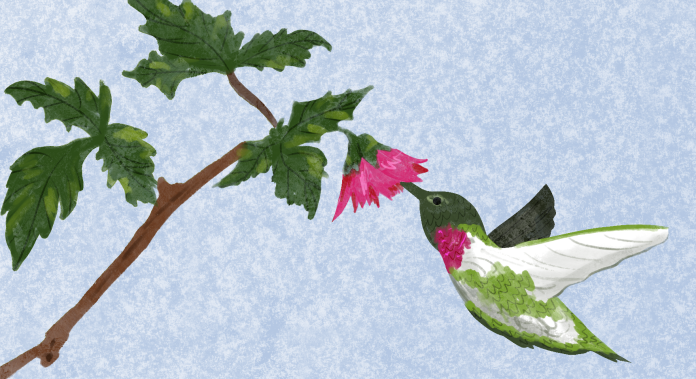Eric Kwon
Science & Technology Editor
Walking to the beach, across grassy areas with batches of flowers, you’ve likely seen Anna’s Hummingbird. Like other hummingbirds, with their incredibly fast metabolism — 77 times faster than that of a human’s — their tiny, yet fast little bodies look curious under the sunlight. Despite their unassuming stature, at a length of four inches, they are a unique and impressive species.
Otherwise known as calypte anna, these birds live throughout the Western United States, having originated from northern Baja California and southern California. Unlike other birds that migrate during the winter, Anna’s Hummingbird stays year-round. As the fall season introduces a wave of colder temperatures, these birds’ presence will be further felt in the absence of their feathered neighbors. In fact, it is the only hummingbird regularly seen in the winter on the West Coast — Santa Barbara’s warmer climate allows these birds to have an easier time as well during these months.
Visually speaking, they are mostly green and gray. The male’s head and throat are covered in iridescent reddish-pink feathers, meaning that its colors fluctuate depending on how the sunlight hits them. The female Anna’s Hummingbird, interestingly, has a small patch of the same unique complexion on her throat.
The most striking feature of Anna’s Hummingbird is arguably their courtship rituals. Like other birds, their visual markings are interwoven into the process of finding a mate. The male needs to woo his potential mate by successfully executing these rituals. After gaining her attention with his bright red headgear and a singsong, he gets into action.
He flies 30 meters above her, preparing for a dive. He flies 30 meters above her, preparing for a dive. He goes down, wings tucked in, about to strike down below. He is a missile, traveling 400 times his length every second. At the very last moment, he swoops out. His tail feathers create an impressive, supersonic-like sound. He’ll know if he’s successful if his potential mate is impressed.
Like other hummingbirds, they drink flower nectar and sap, contributing to plant pollination in the process. However, their dietary inclusion of insects is notable. They eat more insects than any North American hummingbird, and a nesting female can catch up to 2000 insects a day.
Though these feathered creatures are plentiful in the Santa Barbara area, it can be difficult to spot them in the absence of flowers. Although these feathered creatures are plentiful in the Santa Barbara area, it can be difficult to spot them in the abundance of flowers. A hummingbird feeder comes in handy if you want to see them in your porch or backyard.
Hummingbird feeders are simple to make, so going out to buy one is not necessary. With a small lidless jar, a thin piece of plastic can be cut out and placed on the top. The plastic should have small holes (the size of a holepunch) in order to allow the birds to get their food. A bright color for the plastic is useful to attract these birds. Their food is likewise easy to make. A mixture consisting of a 1:4 ratio of sugar and water (without dye) is all that is needed.
Walking across the campus’ fields, or through your own porch with these feeders, you can spot these delicate, charming creatures. Appreciate them for their crucial role in pollination, pest control, quirky behavior, or simply their beauty.











